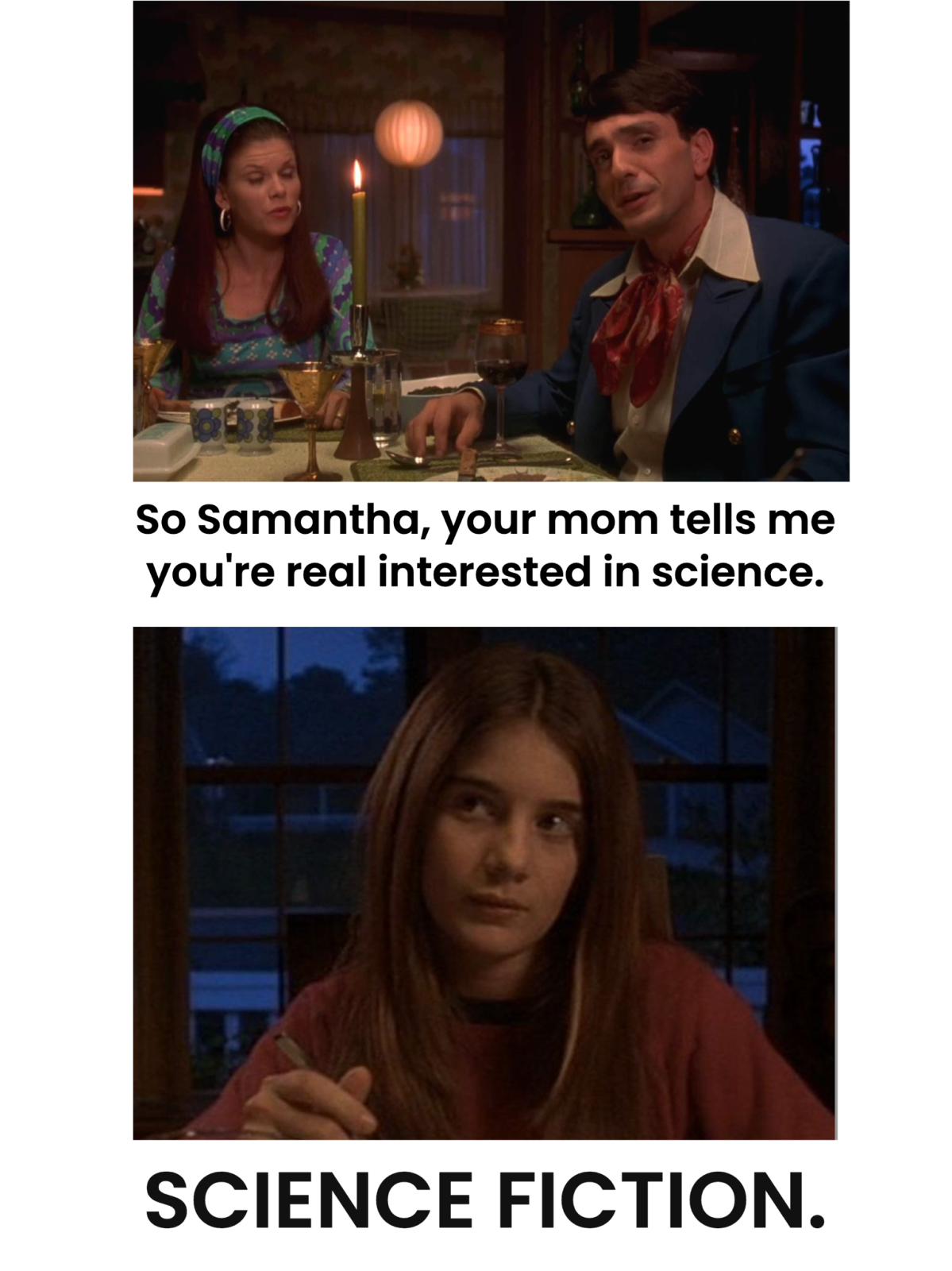
I took a little break from writing this month to deal with many life things — most of them boring, but the most joyous being the arrival of a new niece. So I went to see my sister and spent some time in DC this month — snuggling the baby, running errands, and watching a lot of nonsense television.
One of the nice things about having a break from routine is being exposed to things that you wouldn’t otherwise have chosen for yourself. Which is how I came to watch I, Robot, a movie I had missed in the last 20 years. I think I was initially turned off by the mono-presence of early aughts CGI and Will Smith action thrillers (I still contend his best movie of that era is Hitch).
Anyway, I was wrong to dismiss I, Robot because I found myself engrossed (AI dominance! Locked-room murder theories!). And also that in a 2035 futuristic version of Chicago, we’d still have our hero wear a leather jacket to denote that he is a good guy. The leather jacket is kind of a hero trope in sci-fi:
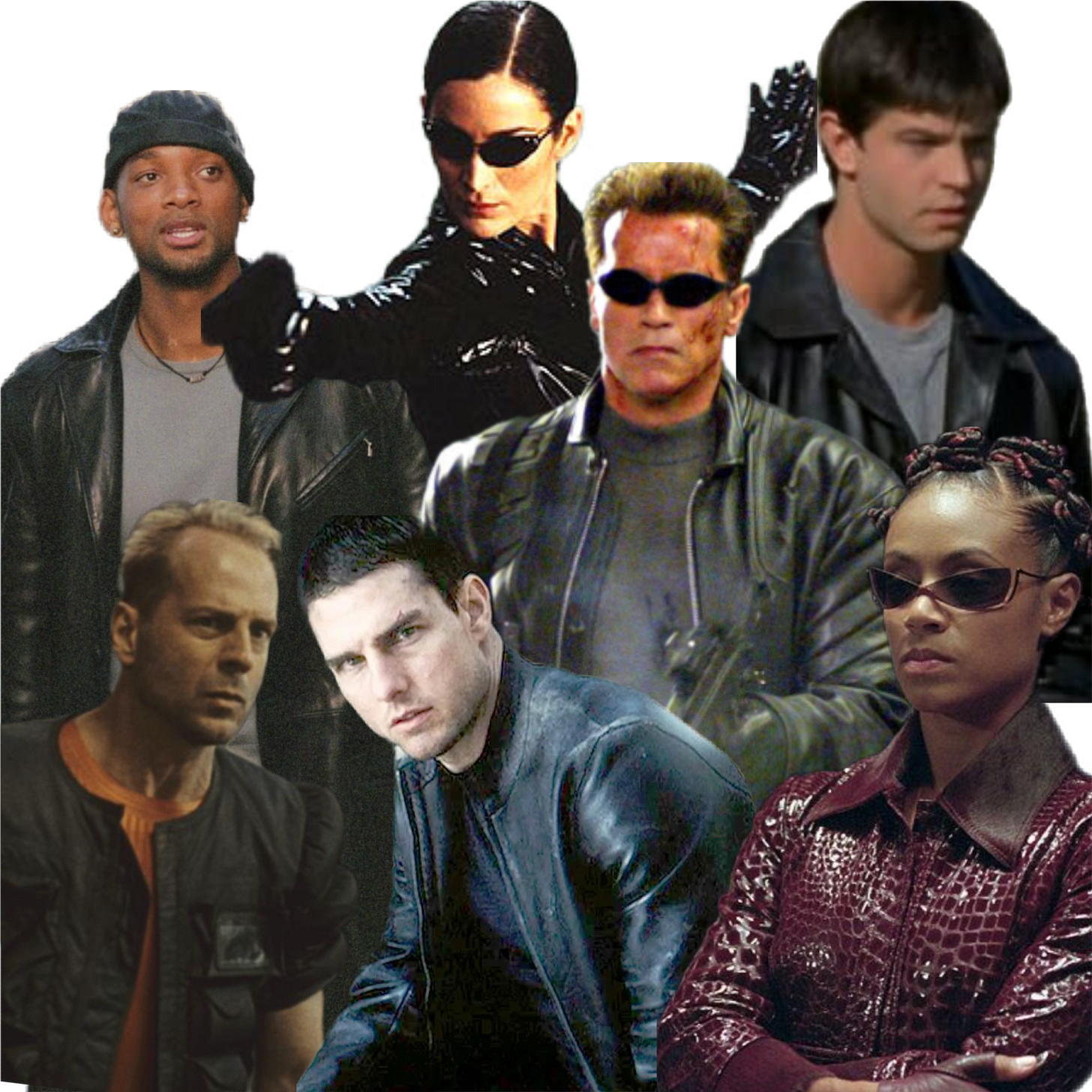
This got me curious about other fashion in Y2K sci-fi media. Why Y2K? The years surrounding the year 2000 had a lot of media preoccupied with (and often optimistic about) the future. This video has a great breakdown of why — obviously Y2K takes its name from the scare, but the aesthetics of the time came from a confluence of post-Cold War economic prosperity, technological advancements in the Internet, and general confidence about the future.

I decided to narrow my scope to:
Y2K as 1997-2004 because that felt right in my heart (and the aesthetics outlasted the actual 2000 transition, for a time);
Mostly video media that had sci-fi elements: aliens/robots, or futuristic vibes;
Excluding spacesuits/uniforms (no Star Trek or Galaxy Quest here) because I am human and
I need to be loveddidn’t feel like it
Some categories started to emerge for these costumes — retrofuturism, techno-Orientalism, and cyber-futurism.
1. Retrofuturism
RETROFUTURISM is a movement known for using retro styles to show the dichotomy of the past at tension with technology and/or futuristic elements. It’s why it’s feasible to see Will Smith wear Converse sneakers in I, Robot even though he lives in a techno-advanced future that could give him better moonboots (but also — sweet, sweet product placement).
Here are some other retrofuturism fashion examples in Y2K sci-fi. While not all of these examples were set in the future at the time of their release, some introduced mid-century anxieties (and fashions) juxtaposed with a tech-savvy present-day (like Men in Black and Stepford Wives).
Suits as a sign of control
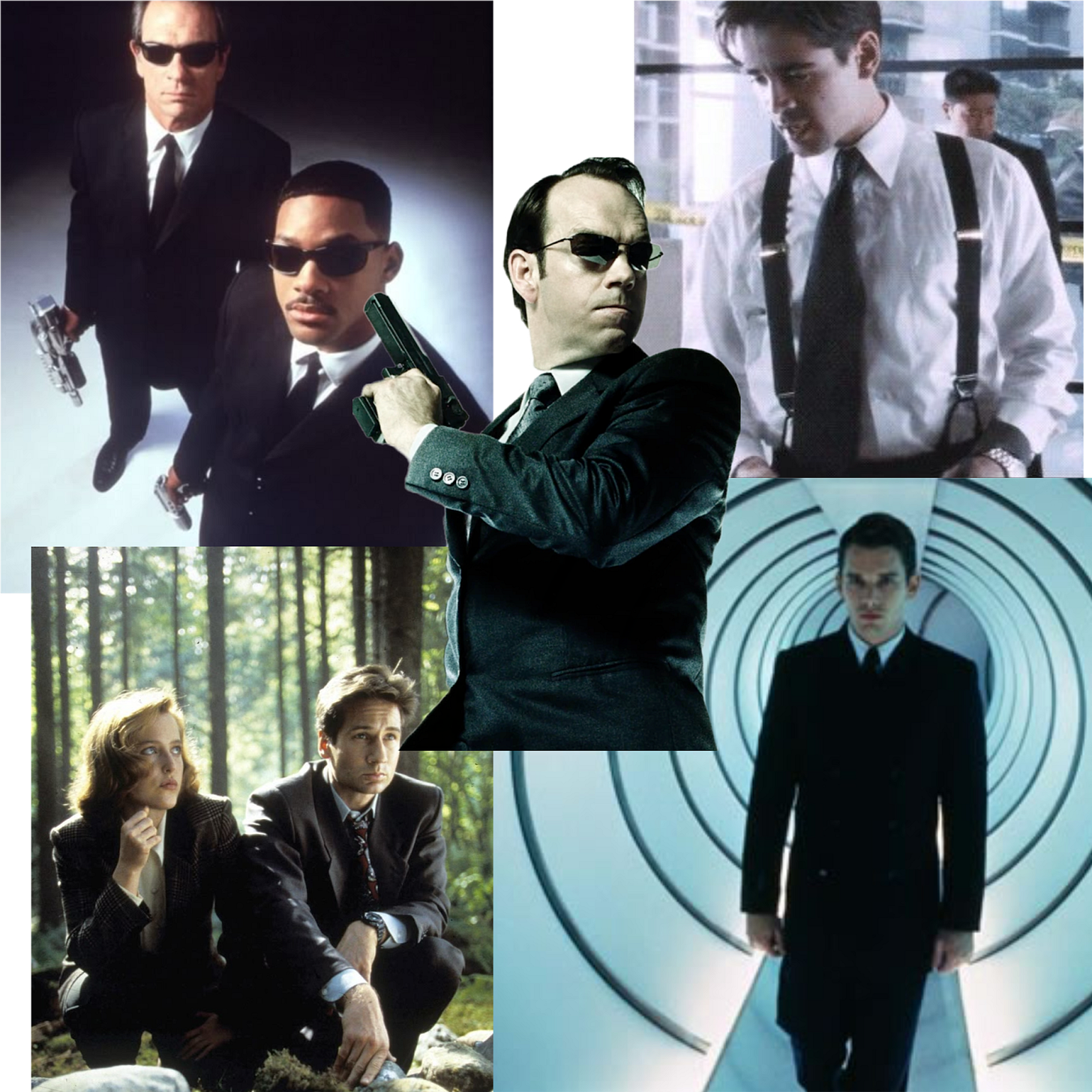
Only in sci-fi is the government portrayed as a reassuring presence. For the X-Files, Men in Black, and Minority Report’s Colin Farrell, dark suits represent the need for control in the chaos of aliens or dystopian hi-jinks. But the suit can also be a stand-in for an evil form of dominance (The Matrix’s Agent Smith) or a symbol of corporatized genetic discrimination (Gattaca). Some of these (Minority Report, Gattaca) have some film noir vibes, with Minority Report costume designer Deborah L. Scott looking specifically to 1940s Humphrey Bogart movies as inspiration for Colin Farrell’s look.
The X-Files tackles the search for control, as Joshua Rothman writes for The New Yorker:
“The X-Files was a retrofuturist show. It celebrated the wide-eyed sense, prevalent in the forties, fifties, and sixties, that science was about to change everything. It also recalled the darkness of the Cold War, when individuals felt powerless against vast geopolitical forces, and science brought us to the edge of thermonuclear doom.”
As Scully’s clothes become less conformist over time, Megan Garber notes they “become a metaphor for her willingness to believe in disbelief. “
Trad femininity to subvert expectations
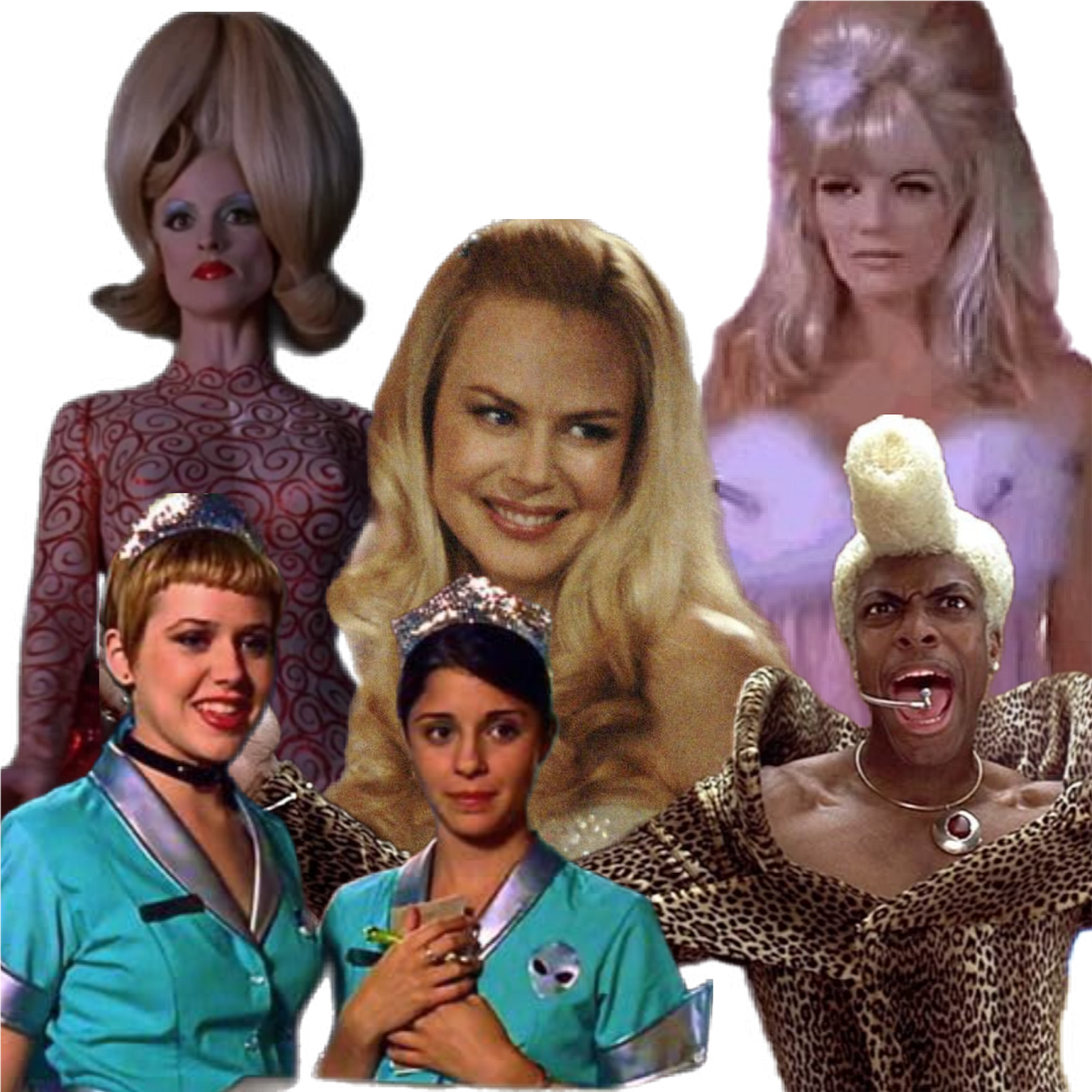
Some sci-fi media referenced mid-century, American ideals of white womanhood. In the tv show Roswell, teens Maria and Liz don kitschy 1950s waitress outfits at their diner job in a town that draws in UFO seekers. For Austin Powers’ fembot, and the Mars Attacks Martian Girl, these traditional gender roles are rooted in misogynistic fantasy and play up situational irony (to attack an unwitting male partner). For The Stepford Wives, the forced tradwife persona highlights the evils of gender slavery.
Perhaps the biggest subversion is designer Jean-Paul Gaultier’s Fifth Element costumes for Chris Tucker’s gender-fluid emcee, Ruby Rhod, who wears clothing reminiscent of 1950s Charles James couture. The role has been both praised and critiqued over the years (is the depiction empowering, or trading in harmful queer stereotypes?). But Rhod’s appearance is a revelation in a genre that very rarely depicts gender fluidity. As Reactor Mag puts it: “[T]here has never been a male character in an action-filled blockbuster who was more openly flamboyant, transgressive, and enveloped in queer codification than Ruby Rhod.”
2. Techno-Orientalism — Asian culture used for future worlds
Techno-Orientalism is a concept often used in sci-fi that uses aspects of East-Asian culture to depict the future. You see it in the anime references and martial arts in The Matrix and the Star Wars franchise borrows from Taoism for the Force and samurai culture for the lightsabers. In the prequels, many of Queen Amidala’s costumes are based on Chinese, Mongolian, and Korean ceremonial dresses.
These depictions come with controversy – while techno-Orientalism may be rooted in appreciation, many movies and tv shows depict scant Asian character representation or demeaning stereotypes. As Liang Luscombe writes for Liminal Mag:
“In the wake of imperial aspirations and consumerist desires, techno-Orientalism describes the West’s imagining of (and anxieties about) East Asia and East Asians, fetishising the East’s perceived technological advancement while further entrenching the West as the architect of both present and future narratives.”
As a Filipino-American woman, I find myself conflicted on the Amidala costumes despite their beauty and technical production, because of the lack of representation in the prequels. But it’s also quite difficult to personally reevaluate and potentially dismiss all Western sci-fi with Asian elements (some depictions are more harmful and problematic than others). Some great additional points on this topic from Mochi Mag, The Hollywood Reporter, and Liminal Mag.
3. Cyber-futurism
I’m using this phrase to encompass what I consider the really techno-fashion from the Y2K era. As Alexandra Fiorentino-Swinton writes for Moda:
“Unlike the ‘60s and ‘70s in which space exploration and extraterrestrial life was the country’s greatest fascination, the late ‘90s and early ‘00s were more occupied with just how advanced and pervasive technology would become. Artificial intelligence, holograms, and futuristic transportation methods were the more pertinent unknowns.”
Some key components of this age include synthetic materials, shiny clothes, and frosty hues, as Leigh Alexander writes for The Guardian. You see this really manifest in the music videos of the era. One of my favorite elements is that a lot of them look like a dance rave shot inside a cheese grater.
Here are just a few fashion examples:
Space BDSM
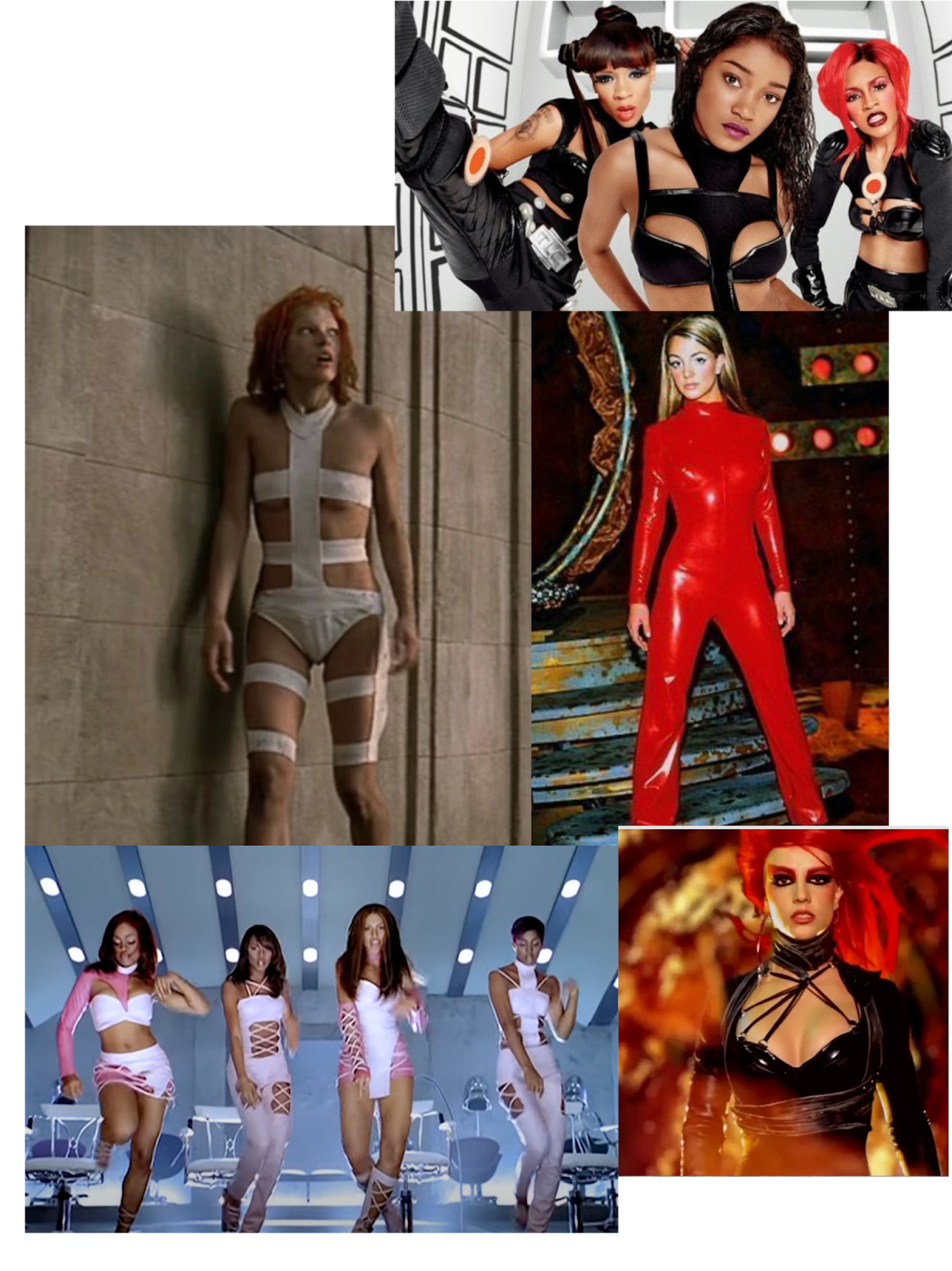
Y2k spacegear had much in common with BDSM-style fashion: straps, metals, leather, and latex abound. Jean-Paul Gaultier’s costumes for Fifth Element were inspired by bondage, lingerie and punk rock. We see other strappy outfits in space-themed music videos, most notably TLC’s “No Scrubs,” Britney Spears’ “Toxic,” and Destiny’s Child’s “Bills, Bills, Bills.” Another big element was latex, found in Britney’s “Oops, I Did it Again” red outfit (which apparently was created in one night).
Shiny and chrome

Silver and chrome were also popular elements for otherworldly costuming. With technology evolving to include the Internet and personal devices, metallic textures became part of a futuristic aesthetic that spanned different mediums. Fun facts time:
Some of the most innovative hip-hop videos of that era were directed by Hype Williams, who did “No Scrubs,” “What’s it Gonna Be?”, as well as Missy Elliott’s “Supa Dupa Fly,” and “She’s a Bitch,” among hundreds of other examples.
Of the precog Agatha’s iridescent costume in Minority Report, costume designer Deborah L. Scott used a new kind of meshy fabric that looked like a second skin and looked good submerged in water.
For The Twins in Matrix: Reloaded, costume designer Kym Barrett based their look on a “Southern evangelist and Jon Bon Jovi” (!)
I’ll end here, but I’ve included more in a Pinterest board! One thing that occurred to me in writing this is how immersive and imaginative the Y2K era was in imagining other worlds. These days, I feel like contemporary sci-fi mainly trades primarily in color-drained, dystopian bleakness (which is why Everything Everywhere All at Once was a revelation — alternate universes can be fun!).
What are your favorite Y2K sci-fi costumes?
Extended Reading:
Frutiger Aero, when the future looked optimistic | Mike Grindle, Medium
Film noir in 90s sci-fi | The Ringer
Why does Sci-Fi love Asian Culture but not Asian Characters? | Slash Film
Fifth Element costume design | Bricks Magazine
Star Wars couture | Vogue







i know this outside the window you looked at (as it’s from 1995). but i must give a shoutout to madonna’s black latex outfit in the Human Nature video! (and we’ll not speak of her hair in that video…) she is often pretty ahead of trends (or WAS, back in the day, i should say—i also thought of her marie antoinette-inspired Vogue performance while reading your post about the French Revolution) so interesting that her sort of cyber look (not sure what the exact right term is) is squarely in the mid-90s way ahead of Y2K